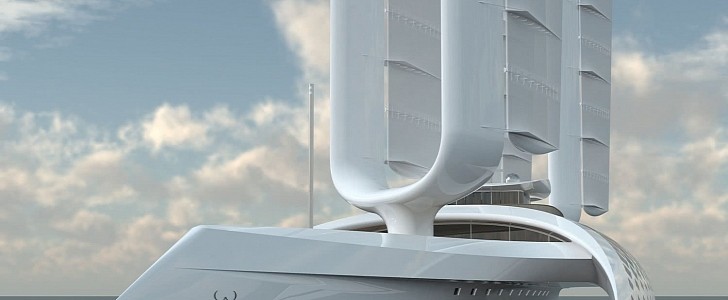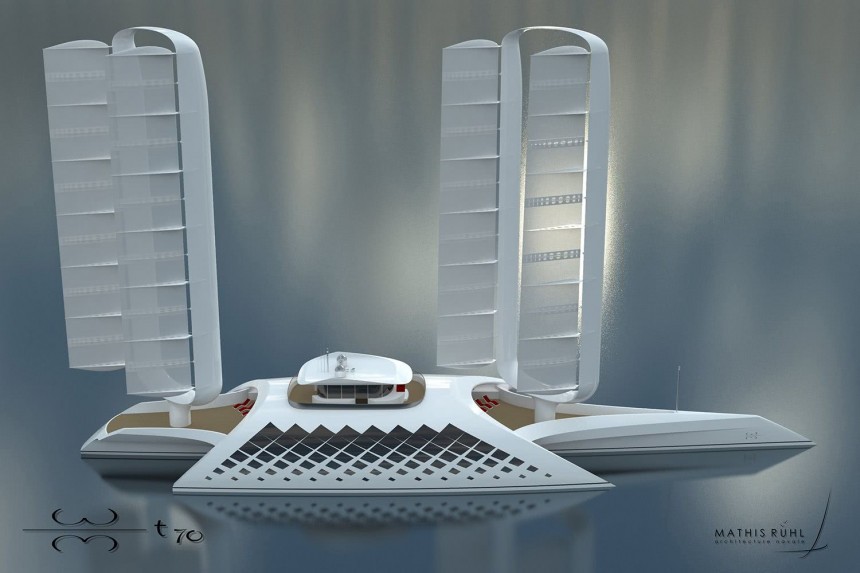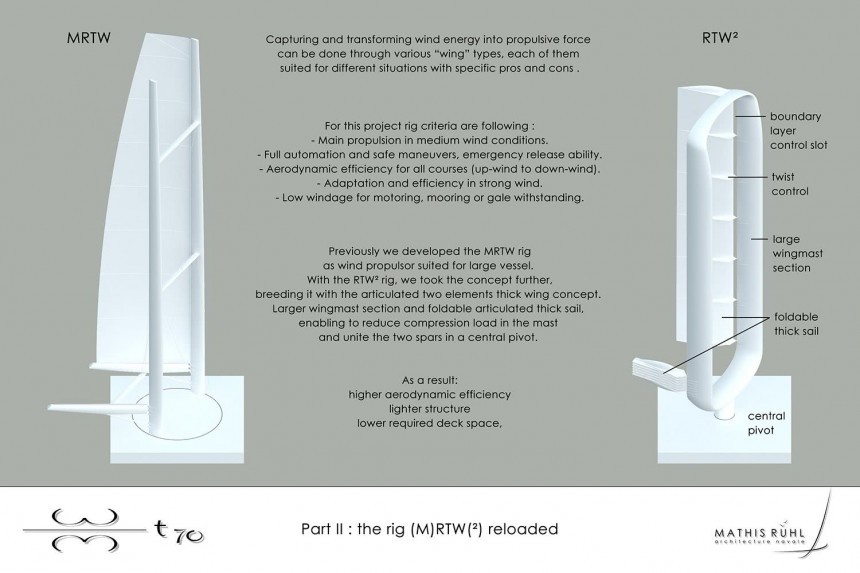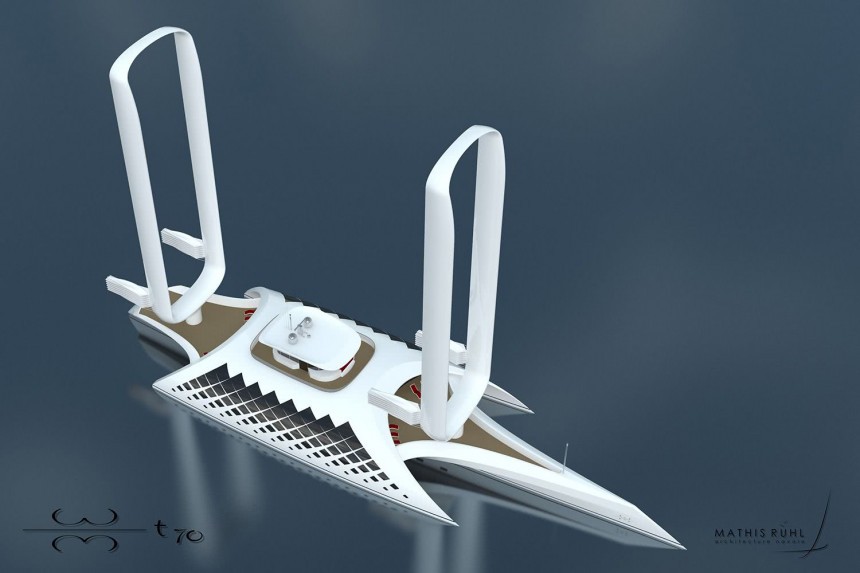If you believe the “tree-huggers,” our planet doesn’t have much life in it if we keep at it as we’ve been doing for the past decades. Even less pessimistic outlooks say change is imperious, so as to cut down on pollution and avoid total disaster.
French naval architect Mathis Ruhl believes that wind power is the future and he’s been dedicating a lot of his time to see whether a yacht or a superyacht could be self-sufficient without alternative or backup propulsion. So far, he’s done several studies of vessels using wind energy as the main system of propulsion, with the most recent being Wind Motion 70.
Wind Motion is a 70 meter (229-foot) trimaran that stands out for its unique aesthetic but, most importantly, for the massive dual rig masts on the deck. Ruhl believes current technology will eventually allow humanity to build ships that travel on wind power alone, thus overcoming all current obstacles.
“We (humans) are all passengers of the same (space) ship (the earth). Damaging it is foolish, (or selfish). It must be avoided,” he writes on his official website. “Trade in goods today is enormous, increasing fast, and essentially made by sea shipping. Global shipping has a significant impact on environmental degradation and climate changing. Shipping operation main pollution factor is due to fuel combustion for propulsion.”
With these facts in mind, he concludes: “Wind energy for ship propulsion is not a nostalgic dream, windship it is a key for a sustainable future.”
Wind Motion 70, like previous studies, was born out of the idea that there is no other future for the yachting / naval industry than wind power. Its goal was to find a solution that would deliver an environmentally-friendly and highly efficient means of propulsion.
Ruhl’s previous projects featured sailing masts, called Multiple Rotating Twin Wingmasts (MRTV, a term he coined in 2015). For maximum efficiency, these were fully automated and adjustable, thus allowing safe and efficient operation even in moderate wind conditions.
This 70-meter concept comes with a modification to the MRTV system: Ruhl calls it RTW² or Rotating Twin Wingmast. This system includes a bipod profile that is self-supporting and that sits on a central pivoting foot, thus occupying less space on deck, offering improved aerodynamics and a lighter structure. The masts and the articulated wings are both automated – the wings fold down and away in the spars when not in use.
The system is designed to offer the main propulsion in moderate wind because the assembly pivots according to wind direction. Automation will also prevent accidents during high winds when at bay or during anchoring maneuvers, or at sea.
For even more efficiency, the masts profile could incorporate 10-meter (32.8-foot) diameter wind generators that would recharge the domestic batteries. This way, appliances and hotel functions could be supported on clean energy as well, with the batteries topping up during anchorage.
Since Ruhl’s study focuses more on whether wind technology alone can be used as propulsion system, Wind Motion 70 doesn’t include addition details like guest capacity or amenities. However, the renders reveal that this superyacht would be a looker, too, thanks to the reverse-angle wave-breaking hull and the curved superstructure dotted with geometrical glazing.
On both the aft and the foredeck, there would be ample space for sundecks and lounge areas, while the skylounge could serve as anything from a roofed dinning area to a club.
For once, though, it feels refreshing to talk about a superyacht concept that hasn’t been designed with the goal to impress some billionaire with its array of toys and luxury commodities, but to make a change in this world – for the better.
Wind Motion is a 70 meter (229-foot) trimaran that stands out for its unique aesthetic but, most importantly, for the massive dual rig masts on the deck. Ruhl believes current technology will eventually allow humanity to build ships that travel on wind power alone, thus overcoming all current obstacles.
With these facts in mind, he concludes: “Wind energy for ship propulsion is not a nostalgic dream, windship it is a key for a sustainable future.”
Wind Motion 70, like previous studies, was born out of the idea that there is no other future for the yachting / naval industry than wind power. Its goal was to find a solution that would deliver an environmentally-friendly and highly efficient means of propulsion.
This 70-meter concept comes with a modification to the MRTV system: Ruhl calls it RTW² or Rotating Twin Wingmast. This system includes a bipod profile that is self-supporting and that sits on a central pivoting foot, thus occupying less space on deck, offering improved aerodynamics and a lighter structure. The masts and the articulated wings are both automated – the wings fold down and away in the spars when not in use.
The system is designed to offer the main propulsion in moderate wind because the assembly pivots according to wind direction. Automation will also prevent accidents during high winds when at bay or during anchoring maneuvers, or at sea.
For even more efficiency, the masts profile could incorporate 10-meter (32.8-foot) diameter wind generators that would recharge the domestic batteries. This way, appliances and hotel functions could be supported on clean energy as well, with the batteries topping up during anchorage.
On both the aft and the foredeck, there would be ample space for sundecks and lounge areas, while the skylounge could serve as anything from a roofed dinning area to a club.
For once, though, it feels refreshing to talk about a superyacht concept that hasn’t been designed with the goal to impress some billionaire with its array of toys and luxury commodities, but to make a change in this world – for the better.












